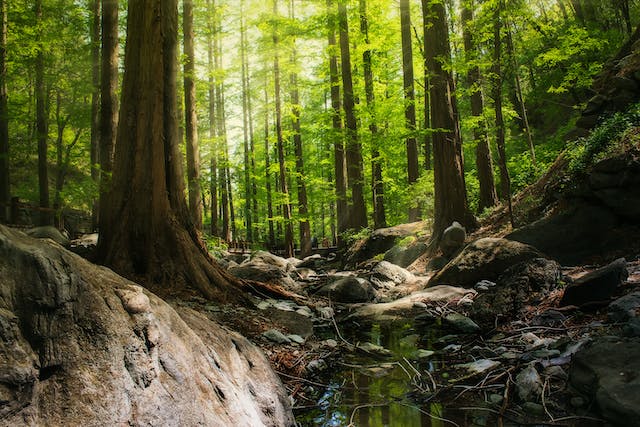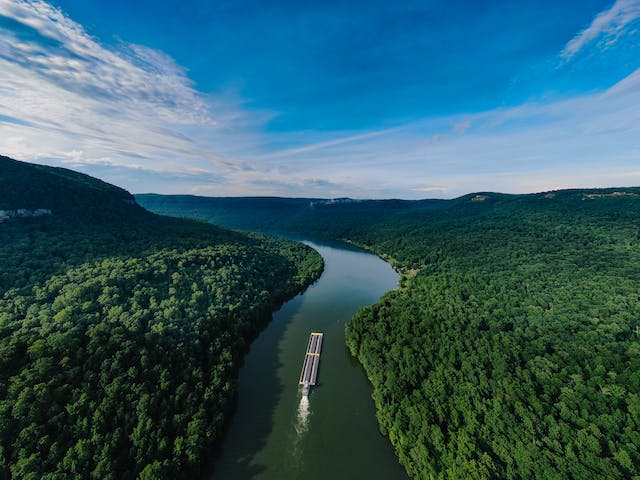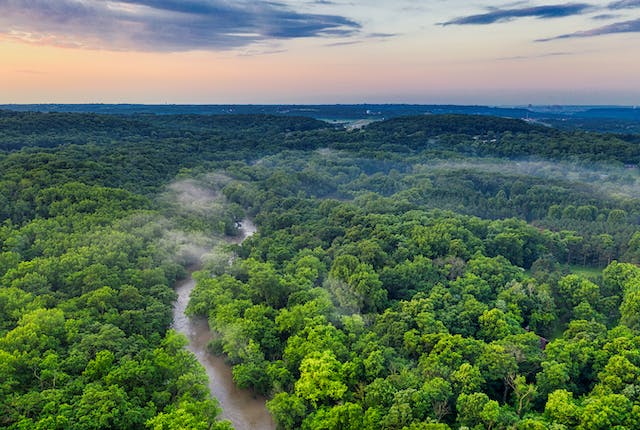When we think of the Amazon Rainforest, we’re often awed by its immense size and incredible biodiversity. Stretching across nine South American countries, it’s rightfully known as the “lungs of the Earth” for its role in producing oxygen and absorbing carbon dioxide. But have you ever wondered just how many trees call this remarkable rainforest home? Brace yourself for a mind-boggling fact: the Amazon Rainforest is home to around 390 billion individual trees!
Page Contents
This sprawling jungle, which spans an area of approximately 5.5 million square kilometers, is teeming with life and wonder. Within its dense canopy, an astonishing variety of plant and animal species thrive, and these trees play a vital role in supporting this rich ecosystem. Let’s delve into the fascinating world of the Amazon Rainforest and explore the incredible trees that make it their home.
The Amazon Rainforest: Nature’s Green Treasure
The Amazon Rainforest is, without a doubt, one of the most iconic and vital ecosystems on our planet. Encompassing parts of Brazil, Peru, Colombia, Venezuela, Ecuador, Bolivia, Guyana, Suriname, and French Guiana, this sprawling expanse of lush greenery has captured the imaginations of scientists, conservationists, and nature enthusiasts alike for centuries.
The Amazon isn’t just any forest; it’s a complex, interconnected web of life, an ecological powerhouse. It’s estimated that this lush rainforest is home to an astounding 10% of all known species on Earth! From jaguars and macaws to countless insects and amphibians, the Amazon’s biodiversity is unparalleled. And at the heart of it all, supporting this intricate web of life, are the 390 billion trees.

Read Also : Nature’s Timeless Treasure: The Eternal Goodness of Honey
The Astonishing Diversity of Amazonian Trees
The Amazon Rainforest is made up of countless tree species, each with its own unique characteristics and contributions to the ecosystem. While it’s impossible to discuss every single tree species in this vast rainforest, let’s take a look at some of the most iconic and fascinating ones.
1. The Mighty Kapok Tree (Ceiba pentandra): The Kapok tree is a true giant of the Amazon, often towering above the rest of the canopy. Its enormous girth and height allow it to stand out in the dense forest, and it plays a crucial role in the ecosystem by providing shelter and sustenance to a wide range of wildlife.
2. Rubber Trees (Hevea brasiliensis): Rubber trees are renowned for their latex-producing capabilities. The rubber extracted from these trees has been a valuable resource for centuries and has played a significant role in the region’s economic history.
3. Brazil Nut Trees (Bertholletia excelsa): Brazil nut trees are famous not only for their delicious nuts but also for their towering height. These trees can reach up to 50 meters and are essential for the survival of various Amazonian animals, including agoutis and macaws, which rely on their fruits for sustenance.
4. Rosewood Trees (Dalbergia nigra): Rosewood trees are highly valued for their dense, dark-colored timber. Unfortunately, this has made them the target of illegal logging, posing a significant threat to their existence in the wild.
5. Sensitive Plant (Mimosa pudica): The sensitive plant may not be as imposing as the Kapok or Rubber trees, but it is incredibly intriguing. When touched, its leaves rapidly fold up, an adaptation that’s thought to deter herbivores and conserve water.
6. Strangler Fig (Ficus aurea): The strangler fig is a tree with a rather sinister reputation. It starts its life as an epiphyte in the canopy, but its roots eventually reach the ground and strangle its host tree. Over time, the host tree dies, leaving behind a hollow fig tree. Despite its macabre growth strategy, the strangler fig provides valuable resources for wildlife.
These are just a handful of the many tree species that call the Amazon Rainforest home. Each of these trees has its unique role in the delicate balance of this thriving ecosystem.
The Amazon Rainforest as a Carbon Storage Superhero
Apart from its biodiversity, the Amazon Rainforest plays a crucial role in mitigating climate change. It acts as a massive carbon sink, capturing and storing vast amounts of carbon dioxide from the atmosphere. Trees are nature’s carbon-capturing machines, and the Amazon is home to more of these machines than any other place on Earth.
The process by which trees absorb and store carbon is known as carbon sequestration. When trees photosynthesize, they take in carbon dioxide and convert it into organic matter, releasing oxygen in the process. This organic matter is stored in various forms, such as leaves, branches, and roots. Over time, this organic matter accumulates, locking away carbon and helping to reduce the concentration of greenhouse gases in the atmosphere.
In the Amazon Rainforest, this process occurs on an astonishing scale. With around 390 billion individual trees diligently sequestering carbon day in and day out, it’s no wonder that this rainforest is often referred to as the “lungs of the Earth.” The carbon storage capacity of the Amazon Rainforest is invaluable in the fight against global climate change.
Threats to the Amazon Rainforest
Despite its vital importance, the Amazon Rainforest is under constant threat. Human activities such as deforestation, mining, and agriculture are taking a toll on this precious ecosystem. Large areas of the rainforest are being cleared to make way for livestock and agriculture, releasing stored carbon back into the atmosphere and destroying habitat for countless species.
Illegal logging is another grave concern. Valuable hardwoods, including those from the rosewood tree, are being harvested without sustainable management, further contributing to deforestation and habitat loss. These activities not only harm the Amazon’s biodiversity but also exacerbate the global climate crisis.
Moreover, the Amazon Rainforest is not immune to the effects of climate change itself. Rising temperatures, changing rainfall patterns, and more frequent and severe droughts threaten the health of the forest. These changing conditions can disrupt the delicate balance of the ecosystem and make it harder for trees and wildlife to thrive.

Conservation Efforts and Hope for the Future
Despite these significant threats, numerous conservation organizations and passionate individuals are working tirelessly to protect the Amazon Rainforest. They’re striving to promote sustainable land use, combat illegal logging, and raise awareness about the critical role this rainforest plays in our world’s climate and biodiversity.
One of the most promising developments in recent years is the increasing recognition of the importance of indigenous communities in preserving the Amazon Rainforest. Indigenous peoples have lived in harmony with the rainforest for generations, and their traditional knowledge is invaluable in conservation efforts. Recognizing their rights and supporting their initiatives is a crucial step in safeguarding this natural wonder.
International agreements and commitments, such as the Paris Agreement and global efforts to reduce deforestation, are also helping to raise awareness and address the urgent need for action. By working together, we can protect this unique and irreplaceable ecosystem for future generations.
Read Also : Illuminating the Skies: The Electrifying Frequency of Lightning Strikes
The Amazon Rainforest: Our Global Responsibility
The Amazon Rainforest’s staggering 390 billion trees are not just part of a distant and exotic landscape. They are essential to the health of our entire planet. The carbon they store, the oxygen they produce, and the biodiversity they support all have far-reaching effects. The health of the Amazon Rainforest is intimately linked to our own well-being.
We must recognize our global responsibility to protect and preserve this remarkable rainforest. Its immense biological diversity and carbon storage capacity are precious resources that cannot be taken for granted. By supporting conservation efforts, reducing our carbon footprint, and advocating for sustainable practices, we can all play a part in safeguarding the Amazon.
As we marvel at the sheer number and variety of trees in the Amazon Rainforest, let it serve as a reminder of the beauty and complexity of our natural world. This extraordinary ecosystem is not only a testament to the power of nature but also a reflection of our capacity to care for and protect the Earth that sustains us.
In conclusion, the Amazon Rainforest’s 390 billion trees are more than just a statistic; they are the heartbeat of a vital ecosystem. As we learn more about these magnificent trees and the role they play in maintaining our planet’s health, we come to appreciate the urgent need to protect them. The Amazon Rainforest is a global treasure, and it’s up to all of us to ensure that it thrives for generations to come.


